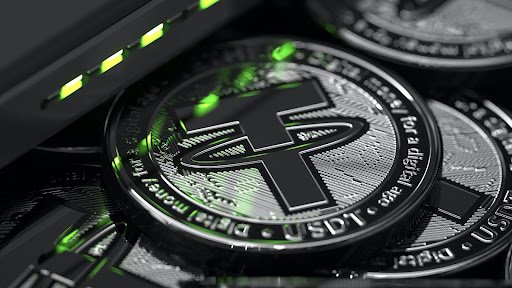Stablecoins: Their Types, Advantages & Disadvantages
Stablecoins are a type of cryptocurrency that provide more stability to the crypto market. Some are backed by the reserve of the asset they represent; others use algorithms or other methods to keep their values from fluctuating too much.
Types of stablecoins
Different stablecoins are pegged by different means to ensure their stability. There are four basic types of stablecoins.
Fiat-backed stablecoins
In other words, users use fiat currencies to buy stables or further exchange. The main difference between such coins is that they retain their stability, as they are backed by real classical money. Thanks to this, stablecoins can be used as full-fledged analogs of USD in the world of digital assets.
Despite all their advantages, there are many disadvantages to stable digital assets. For example, the lack of full security or security in transactions.
Stablecoins backed by other crypto assets
The reserve asset can be volatile and crypto-backed stablecoins are over-collateralized to ensure the value of the stablecoin. A $1 crypto-backed stablecoin can be pegged to a $2 underlying crypto asset.
With this in mind, you need to understand that these assets are less stable than fiat-backed stablecoins and it is a good idea to keep an eye on how the underlying crypto asset behind your stablecoin is performing.
Stablecoins pegged to precious metals, like gold and steel
This is another bridge between the classical financial market and the crypto world. An important difference between such stables is their centralization, that is, dependence on one specific source of data transmission. This is where their main vulnerability lies. On the other hand, attachment to the precious metal protects the asset from volatility or strong price fluctuations.
Algorithmic stablecoins
They are not backed by assets in any way. And that makes them safer, but harder to understand.
Such assets use specially developed algorithms. This allows them to maintain stability and instantly stabilize the course in case of a deviation, which is inevitable.
These protocols work to reduce and increase the supply, as well as artificially manipulate the triggers for buying and selling coins. Thanks to this, control over the stability of the asset price is carried out.
Stablecoins maintain the purchasing power of distressed people
The world saw the great benefits of stable assets during the Ukrainian-Russian conflict. Stablecoins emerged as a way for cryptocurrency traders to avoid the constant conversion of fiat money. As their usefulness became apparent, their use grew. Today they are indispensable for crypto trading, used for cross-border payments, integrated into Web3 applications, and embedded in traditional payment systems.
Importantly, they also allow financially distressed people to maintain purchasing power in the face of runaway inflation, central bank squandering, and war.
The stablecoin Tether has become so valuable that it trades at a premium of $1.10 for an asset that is permanently pegged to $1 in Ukraine. Against the background of the growing volume of sanctions against Putin's aggression, ordinary Russians are changing the ruble for stablecoins.
Last November, the presidential task force and other financial regulators released a scathing report on stablecoins, which suggested that they be fully integrated into the financial system through banking charters or banned.

Stablecoins vs. CBDCs
Meanwhile, central banks around the world, including the Federal Reserve, are either implementing or considering creating their own digital money, known as central bank digital currencies, a.k.a. CBDCs.
However, government versions of cryptocurrencies will not bring the benefits of stablecoins and come with many risks. The prime example is the inclusion of intrusive systems of state control through the social credit system, as we have seen implemented in China. Another great threat is the loss of financial privacy, which is an ever-present danger everywhere.
Events have shown that stablecoins operate outside of the US financial regulatory apparatus. They are the currency of choice when circumstances force people into the most desperate situations.
Unlike government-issued currencies, cryptocurrencies are not controlled by countries and are constantly traded. Cryptocurrency exchange FTX distributed $25 to each Ukrainian registered on the platform.
As tensions escalate between Russia and Ukraine, some citizens are looking for a haven to keep their assets. Since most traditional cryptocurrencies like bitcoin or ether are very volatile, Ukrainians prefer to invest their money in stablecoins, Tether in particular.
Disadvantages of stablecoins
Centralized stablecoins have a significant number of disadvantages. Like many problems in life, there is simply no panacea or elixir to quell all worries and risks. Especially when it comes to a new type of financial instrument, no matter how “stable” it may be.
Centralization
After all, stablecoins are technically nothing new. While their digital property is a breath of fresh air for the stagnating world of crypto and finance, most of it is nothing more than fiat currencies stored on mobile phones or digital wallets.
The problem with centralization is probably the biggest risk associated with stablecoins at the moment. For one, it goes completely against the general ethos of blockchain technology. As they say, the blockchain was designed to truly decentralize the information age so that no single party has complete control or dominance over any aspect of our technological world.
Lack of transparency
It was also supposed to bring with it a layer of transparency and immutability that technologies like the Internet simply don't provide. For the most part, this is true. Transactions are completely transparent and immutable on public blockchains.
As a result, they are not controlled and cannot be changed by one party. Unfortunately, this is not the case for stablecoins. There is often a single entity that controls and manages the stablecoin with off-chain transactions and trades.
USDT as an example
Let’s take USDT as an example, the most widely traded stablecoin on the market. USDT is controlled by a company called Tether, which acts just like any other profit-maximizing company in its interests.
Tether controls both the supply and distribution rate of USDT and is not responsible to outsiders for how they choose to manipulate market supply. Being a centrally maintained asset goes against the nature of blockchain technology, although not technically.
This lack of decentralization creates obvious risks for anyone holding USDT. A crash in Tether for any reason also means a crash in USDT, which could cause your digital US dollar to drop in value to zero.
The best way to deal with this is probably the one that most investment managers advise you to do, by diversifying your assets. By diversifying your set of stablecoins, you can at least protect yourself from the collapse of the entity in charge of the asset.

Five prime stablecoins to invest in
Diversifying your portfolio is the key to protecting yourself. You can choose whichever coin you see fit for yourself, but here we have listed the 5 most common ones.
Tether (USDT)
USDT is one of the most famous, voluminous, and reliable stablecoins on the market. Each Tether token has a corresponding $1 collateral deposited in its account. Purchasing USDT is easy as many exchanges support it and there are many tutorials on how to buy USDT.
The problem with moving these coins can be the fee, depending on the exchange you use. Binance charges a 1USDT fee. However, the TRON network has implemented a new protocol, so the TRC-20 transfer fee is 0.1USDT. It is almost free.
While serious questions were raised regarding the company's accounting practices, the price of the token remained stable within a deviation of $0.05. However, according to TradeCrypto, Tether cut USDT collaterals by 17% in the first quarter of 2022.
Supported wallets: Metamask, Trust Wallet, TronLink, Exodus, Trezor, Ledger, MyEtherWallet
Staking: AAVE - 3.27%, Compound - 8.5%, Yearn - 3%
Dai (DAI)
Dai is a decentralized stablecoin pegged 1:1 to the US dollar; collateral against Ethereum. To create Dai tokens, users must purchase and stake an equal value (in USD) of Ethereum tokens.
As Dai prices rise, there will be an incentive for users to create more tokens. When the price falls, users will have an incentive to sell their assets back to the pool.
Supported wallets: Metamask, Trust Wallet, Ledger, Trezor, MyEtherWallet
Staking: Compound - 3.26%, Aave - 1.49%
USD Coin (USDC)
USDC is a 100% USD-backed stablecoin issued by the CENTER Consortium. Each USDC token corresponds to one US dollar held in its account.
Decentralization is enabled by allowing many different projects to join the network of USDC issuers overseen by the CIRCLE project, each of which maintains its cash reserves to stabilize the tokens it issues.
At the same time, oversight of CIRCLE can hedge against fluctuations in value by allowing third parties to issue USDC on their own.
Supported wallets: Metamask, Trust Wallet, TronLink, Exodus, Trezor, Ledger, MyEtherWallet
Staking: Compound - 5.21%, Aave - 2.08%, dydx - 9%, Yearn - 3%
Binance USD (BUSD)
Binance USD (BUSD) is a new USD-denominated stablecoin approved by the New York State Department of Financial Services (NYDFS), launched in partnership with Paxos and Binance.
BUSD is 100% backed by reserves held in either one or both of (i) fiat money in dedicated omnibus accounts with insured U.S. banks and/or (ii) U.S. Treasury bills (including through repurchase agreements and/or funds money market investments in the US Treasury) accounts.
Supported wallets: Ledger, MyEtherWallet, Trust Wallet, Trezor
Staking: Aave - 2.86%, Celsius - 8.2%, Blockfi - 8.6%
TrueUSD (TUSD)
The first regulated coin to be issued, TUSD was a novelty to the industry. The company behind it TrustToken Inc. was audited by Cohen & Co. This level of transparency assures the stability of the token fully backed by the US dollar.
The only issue is that the platform is not fully decentralized. Any changes to the native platform of TUSD can cause potential losses to crypto traders.
Supported wallets: Ledger, Metamask, Trust Wallet, Tronlink, Binance Chain Wallet
Staking: Aave - 1.46%
Conclusion
It is important to understand that there are risks associated with anything, especially digital currencies, even if they are as stable as stablecoins. This dynamic space will develop, grow and fragment into new areas at the speed of light. This is exciting, and for many, this is exactly what the blockchain space needs.
We expect to see how the centralized stablecoin risks we have listed above play out sooner or later in the year. We advise using decentralized stablecoins which, at least for now, represent a better option.
But who knows, as the crypto market grows and evolves, maybe we will see new risks arise by the next time we revisit this topic.
About the author
Nina Petrov is a theoretical mathematician, passionate about new trends in the global economy and blockchain technology. She is a devoted content creator and editor, crypto-enthusiast and stock market analyst.